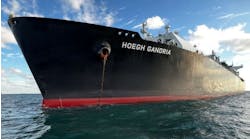GLOBAL FORECAST 2002: Challenges for long-term hull deployment
Building an information technology system in which recorded key data is able to manage the hull maintenance of an offshore structure is the wave of the future. Naval arch-itects working with offshore structures face a technical hurdle. They need to accurately predict loading patterns, fatigue life, coating breakdown, and corrosion with a limited knowledge base. Add to this the fact that the lifetime expectancy for floating structures almost always increases beyond design life, as the field is developed.
Long-term condition predictions are the key in order to optimize the timing and impact of maintenance by appropriate repair of coatings and timely repair of the structure. Keep in mind that floating production structures are designed and maintained in such a way as to avoid drydocking and minimize the amount of steel replacement that is required during the vessel's lifetime.
The long-term need to accurately predict deterioration of the hull structure is moving the industry toward electronic management of the information on a vessel-by-vessel decision basis. In the short-term, designers are relying on knowledgeable experts and anecdotal evidence from shared data. There is a presumption that these predictions can be easily extrapolated from current worldwide floating structure case studies. However, the problem is more complex. For example:
- Corrosion rates have not been publicly, or perhaps even privately, available for many of the floating structures in place.
- Fatigue calibration methodology for ships differs markedly from that appropriate to floating production structures.
- Characteristics of the stored oil may cause marked differences in corrosion and pitting rates.
- Characteristics of the coating material, the ambient conditions, and conditions during application may cause marked differences in coating life and suitability.
- Coating technology has improved vastly in recent years, and scientific tests are now available to predict time to breakdown and additional time to steel replacement.
- Corrosion rates may be higher for some structures because of the more frequent use of saltwater ballast tanks.
- Trading tanker corrosion rates are expected to be much different from a moored vessel in a tropical environment acting as a production structure.
Progressing this knowledge base for floating structures involves the following:
- Hull monitoring: Recording hull stresses and correlating these with the predicted stress regime leads to a better understanding of our engineering tools, such as fatigue predictions. For floating structures, these fatigue predictions need to be accurate for 20-30 years operation at specific sites.
- Hull condition maintenance: Coating infor-mation can be used to make timely repairs to avoid later steel replacement where coating breakdown occurs. Decisions on the replacement of steel are timely and important before serious problems develop.
- Hull maintenance documentation: A comprehensive system by which an operator can monitor the condition of a vessel's hull structure throughout its working life is needed. This includes a technical model of the vessel, its structural data, and survey history, including details on all repairs and modifications.
Hull condition status
With the electronic age, a fleet manager in Houston can know the ongoing hull condition status of a vessel in West Africa, India, or China, both visually and electronically. Hull maintenance systems can regularly and accurately record and monitor trends. Parameters can be set to alert the owner when rates of corrosion or anticipated costs exceed the average. These packages contain the ability to automatically generate shipyard specifications, coating area calculations, when a repair is required, and time to obtain competitive and accurate quotes.
The major classification societies are developing and maintaining these packages. The next step should be a drive toward standardization, so data can be interchanged and compared for trending. The basic characteristics of a hull maintenance package are:
- Modeling a structure so that a true structural database with isometric views can show steel replacement
- Recording a history on a structure through gaugings, anodes, pittings (tracking severity), coating condition (with several measured datapoints), damages, repairs, and inspections, including the definition of critical areas
- Photographs incorporated for a historic visual record
- Automatic generation of repair specifications
- Damages recorded in the system
- Structure color-coded, according to the corrosion levels or coating deterioration found on the vessel
- Using a 'rules' feature, so that the user can set up criteria that generate automated repair requirements, according to classification rules.
As class societies develop hull maintenance packages with features to enhance the asset integrity management of the full lifecycle of offshore structures, an electronic knowledge database will be available industry-wide. The growing acceptance of the importance of managing the hull condition in offshore structures underscores the importance of hull maintenance software. This technology will become a vital tool in an operator's overall asset integrity management plan for the future.
Dr. B.P. Malcolm Sharples is a Consulting Engineer, working with the Offshore Project Development Team at the American Bureau of Shipping. He holds a BS in Engineering Science from the University of Western Ontario, and a PhD in Structural Engineering from Cambridge University. Prior to joining ABS he was President of Noble Denton & Associates Inc., where he specialized in offshore and enterprise risk evaluations.




